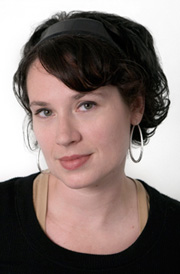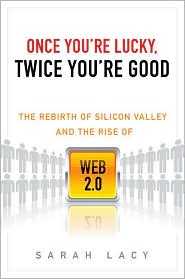 I recently interviewed Sarah Lacy, BusinessWeek reporter, Tech Ticker host and author of the book “Once You’re Lucky, Twice You’re Good: The Rebirth of Silicon Valley and Rise of Web 2.0” (scheduled for release tomorrow).
I recently interviewed Sarah Lacy, BusinessWeek reporter, Tech Ticker host and author of the book “Once You’re Lucky, Twice You’re Good: The Rebirth of Silicon Valley and Rise of Web 2.0” (scheduled for release tomorrow).
Sarah and I had an in-depth conversation about her new book, life in Silicon Valley, Twitter, her infamous SXSW interview, and much more.
You have a new book coming out, could you tell us more about it?
The book is called “Once You’re Lucky, Twice You’re Good: The Rebirth of Silicon Valley and Rise of Web 2.0”. While it’s about Silicon Valley, it’s really written for people outside Silicon Valley who heard all about the dotcom bubble, heard all about the bust and then heard nothing about Internet companies for a long time. Then out of no where we started hearing about MySpace, YouTube and Facebook, a lot of these modern Web 2.0 companies. And there were a lot of misunderstandings about what this wave of companies meant. There were a lot of stories saying it’s like 1999 again, but it couldn’t be farther than 1999 again…
I’ve covered start ups in Silicon Valley for about 10 years. Stayed in close contact with a lot of my sources after the bust. I had a front row seat as a lot of these companies were bubbling back up. When it started to become a big story and I felt like I was seeing it was being reported on so wrong over and over again and people didn’t really get it, I felt like I was in a unique position to be the person to help these guys tell their story.
 So what are some of the things you and the entrepreneurs you write about see as different than 1999?
So what are some of the things you and the entrepreneurs you write about see as different than 1999?
I think one of the biggest things is you look at who was the most important person in a Web 1.0 company vs. a Web 2.0 company? In the dotcom days, it was the business development guy. The Internet then was all about doing these big content deals or revenue sharing deals with all the old economy companies. And it was really common in San Francisco to see a lot of business school drop outs wearing blue shirts and khakis and hanging out at the champagne bar, called the Bubble Lounge, they order a bottle of Cristal and smoke cigars and being mini ‘Masters of the Universe’. None of that is happening now.
The most important person in a Web 2.0 company is the engineer. I think that it makes sense, because if you think about these companies the bulk of their content and the bulk of what makes these sites special is the community of users that are really providing what’s important on the site. If you look at Facebook or LinkedIn or something even more extreme like total user generated content like YouTube or blogs, you don’t need a bizdev guy because this isn’t a deal like AOL-Time Warner, we’ve got this big portal let’s go put some content on it. Obviously those plays didn’t work when we look back at it.
This is a phenomena that is driven up by the users. People at these companies just need to build the best design, the best user interfaces, the best networks to make sure scales to make sure it’s robust and intuitive and easy to use and beyond that get out of the user’s way.
On the topic of culture in Silicon Valley, you’ve got a chapter in the book called “F-ck the Sweater Vests”. Interesting title, tell us more what that’s about.
That’s Jay Adelson, the CEO of digg that’s his rallying cry. By sweater vests, he refers to old school business people venture capitalists, gate keepers. Jay started a networking company and he had a brutal experience during the bust. He got screwed over by a lot of people he trusted in the industry. That’s where “F-ck the Sweater Vest” came from. That sense is a large part of why these companies were built the way they were, using angel money, using cheaper or free open source software not having to go to the sweater vests until you had something so great that they had to do it on your terms.
For people who are not in Silicon Valley who are reading this book, what do you hope they take away from it?
I wrote the book for those people. I try to give a real flavor of Silicon Valley. The launch parties get a lot of attention. But this is really just a place where people who are nerds, people who love building stuff, people who can’t work for anyone else, who are just misfits and they feel this immediate sense of home and belonging and as bruising as the bust was, that’s why so many people didn’t leave.
There are a couple of scenes in the book of parties at people’s houses, not these big launch parties or company parties. These guys forge these deep relationships because of what they go through socially, what they go through emotionally, it’s something that’s very unique in the valley. Just being able to relate to each other. There’s this deep glue that holds these people together. So it’s not surprising that a lot of these guys back each other’s companies, even if they’re competing with each other, there’s some way in the Valley that work and friendship are able to co-exist.
There’s also a certain way of doing business in the Valley and I take people through raising a funding round in an easy to understand way, demystifying all the terms and technical jargon.
When you live and work in the Valley you see so many times at a movie theatre, two guys run into each other and they ask what they’re each doing. And maybe that chance meeting turns into an angel investor investing in his friend’s company. Or maybe that other friend ends up working on something and they end up being partners.
There are thousands and thousands of these throw away moments in Silicon Valley life that lead to why these companies wind up being hugely successful. It’s something you have to live here to experience. It’s the magic of Silicon Valley.
Well those are the upsides, what are some of the downsides of Silicon Valley?
It’s probably the personal toll that it takes on you. It’s a brutal, brutal life here. Even for me, and I’m not even starting a company, there’s this expectation, this macho thing in Silicon Valley that you’re going to work 48 hours each day, that you’re going to find a way to carve out another 24 hours and get stuff done.
Things move very fast here and you have to be on top of it. Not just if you’re starting a company but if you’re investing in one, if you’re writing about them, if you’re an attorney.
It’s an all consuming scene here and that can get very exhausting for people. It’s obliviously not a really healthy work life balance.
But also, these guys can go from being a nobody to being on the cover of business magazines in such a short period of time. It’s very hard when you’re a single guy to date in that situation. It’s hard to make friends with people in that situation. That’s why these guys cling to each other.
You go from someone who’s really shy and doesn’t necessarily want to go to a lot of parties or talk to a lot of people to not wanting to go to a lot of parties or talk to a lot of people because you get mobbed.
These guys become celebrities just as much as anyone in Hollywood. They don’t start out with that goal. Sometimes there’s the sense that ‘I didn’t want this.’
##
Related Links:
Go2web2.0 (Orli Yakuel): An Interview with Sarah Lacy Regarding her New Book
The NEXT web: Once You’re Lucky, Twice Your Bloody Lucky!
CNET TV: Loaded: Once you’re lucky, twice you’re good
TechCrunch: 10 Signed Copies of Sarah Lacy’s “Once You’re Lucky, Twice You’re Good”
CenterNetworks: Sarah Lacy on Fox Business Explains What Web 2.0 Is and Why LinkedIn Is Hot
The Secret Diary of Steve Jobs: Smoking hot Sarah Lacy has a smoking hot book ranked #1 on Amazon
AllFaceBook: Mark Zuckerberg, Sarah Lacy Interview Video